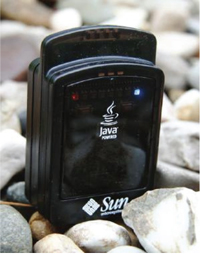by Manfred Bortenschlager, Elisabeth Haid and Andreas Wagner
Sensor technology has the potential to boost productivity just as the Internet did. We demonstrate the opportunities presented by sensors and sensor network technology by deploying a corresponding framework in an indoor environmental quality application. Our framework is based on OGC Sensor Web standards and exploits SunSPOT sensor technology for rapid prototyping.
Due to the restrictions of industrial sensors, the engineering of applications that exploit sensor network technology is difficult. Such sensors are usually proprietary and inflexible as regards programmability, reusability and applicability to different domains. As a result, testing, extending and porting an application based on a sensor network is expensive. Java-based SunSPOT sensor technology has been developed for rapid prototyping of such applications and for testing and verifying algorithms on a small scale prior to deploying them in industrial operation. We demonstrate this methodology in the development of an indoor environment quality (IEQ) assessment application that exploits SunSPOTs. This application is based on a wireless sensor network, adopts OGC Sensor Web standards, and provides a visual interface to the sensor values.
SunSPOT Sensor Technology
SunSPOTs are embedded hardware modules that are equipped with a 180 Mhz CPU, 512 KB RAM, 4MB flash memory, three on-board sensors (temperature, light and three-axis accelerometer), hardware interfaces for the integration of arbitrary external sensors, and the IEEE 802.15.4 wireless transmission technology, which is enabled for mesh networking. SunSPOTs are entirely programmable in the Java programming language and thus help to abstract from the underlying hardware. No direct interaction by machine code with the hardware is necessary, which significantly eases the development of sensor-based applications.

The SunSPOT sensor technology was developed primarily to satisfy three target groups: education (introducing pupils and students to related topics such as programming, networking, embedded systems, robotics or hardware), research and development (allowing for fast implementation of systems that integrate sensor technology and for easy testing of their behaviour), and hobbyists (developing small sensor-based applications for personal needs).
One of the major design goals of SunSPOTs was to provide a tool for rapidly prototyping sensor-based applications, and for testing and verifying algorithms on a small scale prior to deploying them in industrial operation. This tool can be exploited to reduce costs by evaluating novel algorithms a priori before adapting them to real-world problems.
This form of sensor technology will prove useful in a broad spectrum of applications and domains, such as early detection and warning systems, environmental monitoring, automotive engineering, warehouse/container management, logistics, monitoring of buildings, home automation, weather forecasting, medical monitoring of patients and diagnosis, and agriculture and farming.
Application: Indoor Environmental Quality Measurement
Based on SunSPOT sensor technology we developed an indoor environmental quality application. Factors that influence the climate in a room and contribute to human well-being are measured at different positions in a room. The sensor data, then, can be retrieved from the sensors and are further processed in our sensor network.
Each sensor station is composed of two main components, namely (i) an external sensor which can measure electromagnetic pollution, air pressure, humidity, air temperature, brightness, noise or carbon dioxide, and (ii) a SunSPOT module which is responsible for pre-processing acquired sensor data and propagating them through the sensor network.
The base station managing this sensor network is an OGC-compliant Sensor Web application. It allows for administration of the sensors, and reading and processing of sensor data; for example, users can visualize and interaction with current sensor values on a graphical, Web-based interface. In particular, the Sensor Model Language (SensorML), Observation & Measurements (O&M), and Sensor Observations Service (SOS) specifications are adopted.
Communication between the sensor and the base station can occur in both push and pull modes and in a regular or on-demand fashion, where the values are communicated over the meshed wireless sensor network. All configurations can be defined by the user during run-time. In addition, a user can employ a sensor value reader device (essentially another SunSPOT) in order to get data from a specific sensor by physically moving into the communication range of that sensor and querying the accordant data.
Future Activities
Further research will focus on the enrichment of the visualization component by correlating it with information potentially coming from other, external sources such as the Internet. This should be achievable with reasonable effort due to the adoption of open Sensor Web standards. In addition, methodologies will be investigated that will allow algorithms and functionalities that were successfully verified on a SunSPOT platform to be ported to non-Java sensor platforms with minimal effort.
The work presented here is part of the MobilityLab, a Centre of Excellence on the Engineering of Location-Based Systems, and involves Sun Microsystems, Vienna University of Technology (Institute for Geoinformation and Cartography) and Salzburg Research.
Links:
https://www.sunspotworld.com/
http://www.opengeospatial.org/projects/groups/sensorweb
http://mobilitylab.salzburgresearch.at
Please contact:
Manfred Bortenschlager
Salzburg Research Forschungsgesellschaft mbH / AARIT, Austria
E-mail: manfred.bortenschlager![]() salzburgresearch.at
salzburgresearch.at










